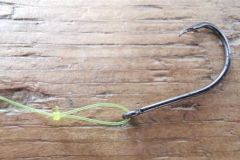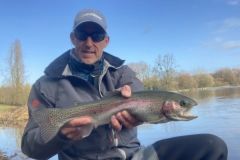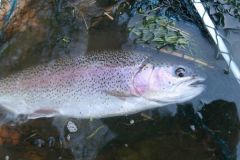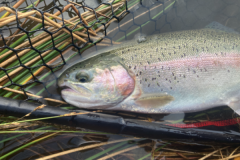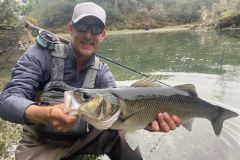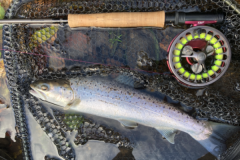At this time of year, the rivers are closed and many of us go to the reservoirs to extend the season or simply for the pleasure of this often-discredited type of fishing.
It's true that reservoir trout are not wild and have been introduced, but they learn fast and quickly become smart, wary fish. So you need to find something they like to fish with.
In autumn, it's possible to fish virtually all reservoir fishing techniques, from dry fly to sink-fishing and drowning. In fact, it's great to be able to catch trout on the surface and at different levels on the same day. It's a great time to mix techniques.
It's often active, fast fishing, as the water is still at the right temperature, which is very pleasant. Here are a few flies to have in your boxes for this reservoir restart, but also for the rest of the season.
1-Montana
This fly was originally invented to imitate a plecopter larva, but in the end it imitates everything and nothing at the same time, which is its strength. It's one of the basic streamers/nymphe for reservoir fishing at any time of year.
When you're not sure what to use, the montana will allow you to catch a few fish thanks to its colors and shape, which interest trout.
It can be fitted with a thorax of different colors (orange, yellow, green, etc.), and also in several sizes. Sometimes a bead in the head allows it to swim more jerkily and dive faster.
A fly that can be used as a tippet, with a nymph or a chiro, or on its own. It must be used in the right layer of water, using the right density of line to match fish activity.
Montana Fly Tying Sheet
- Hook: Kamazan B830 size 8
- Tail: More black hen fibers
- Body: Black caterpillar
- Thorax: Chartreuse fluorescent caterpillar + black hackle
- Head: Mounting silk

2-Worms app
Worms app are very long, thin worm imitations. They have found their way into the tackle boxes of some reservoir anglers over the last few years, including myself. They are not widely used, but they can be extremely effective in certain reservoirs and at certain times of the year. In autumn, they're often very busy.
To be used as a duo or on its own, as a tip or as a stem. You'll need to find the right color and animation for the moment, not to mention the water layer. Fast to very fast animations are often used, but sometimes you have to do just the opposite! A fly to be tested during a fishing trip, as trout can be sensitive to the vibrations created by these flies and trigger them when nothing else works. Some days trout go crazy for them.
Worm app assembly sheet
- Hook: Dohiku blob size 8
- Tail and body: Red, pink, olive, black thread lure... A wide choice of colors is available.
- Head: A ball can be used as a head

3-Shipman buzzer
The shipman buzzer is another must-have, especially for surface fishing in reservoirs when trout are on "chiros". It imitates an emerging chironomid larva that positions itself in the water film. Available in various sizes and colors. Can be used as a gallows on a chiro train of 2 or 3 flies. Shipman on top and one or two chiro nymph imitations underneath. Can be used static or when knitting silk.
Assembly sheet Shipman buzzer
- Hook: Kamazan B400 size 12
- Tail: Polyfloss or white antron
- Body: Spectra dubbing Hends color 46 + Kristal flash pearl strapping
- Head: Polyfloss or white antron

4-Chironomid pupa
Chironomid nymphs are widely used in reservoirs, as once again this insect is the staple diet of pond fish.
This pattern gives me very good results whether used as a jib over a streamer, or as a tippet on a train of chiros. Mainly used by knitting silk, or in small strips (pulled).
Available in various sizes, with or without ball.
Chironoma nymph assembly sheet
- Hook: Tiemco 2457 size 10
- Body: UTC 70 black silk + kristal flash pearl strapping
- Thorax: Peacock herl + white antron
- Head: 2.5 mm silver ball

5-FABs
The FAB or Foam Arse Blob, literally a blob with a foam butt, is a floating version of a blob.
They are used in various reservoir fishing techniques either to support one or two flies at a certain height or below the surface in washing line (clothesline technique), or on a bottom fly train (boobies, blob). It can also be used alone or in duo on intermediate to plunging silks to tease trout. They displace a lot of water due to their shape and the foam at the bottom of the fly. They can sometimes work miracles. You'll have to vary the colors to find the one of the day!
FAB assembly sheet
- Hook: Dohiku blob size 8
- Tail: Foam cylinder for cut booby eyes
- Body: Blob caterpillar


 /
/ 



